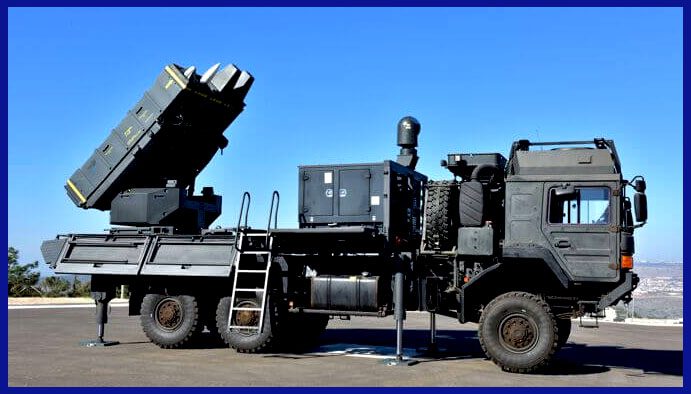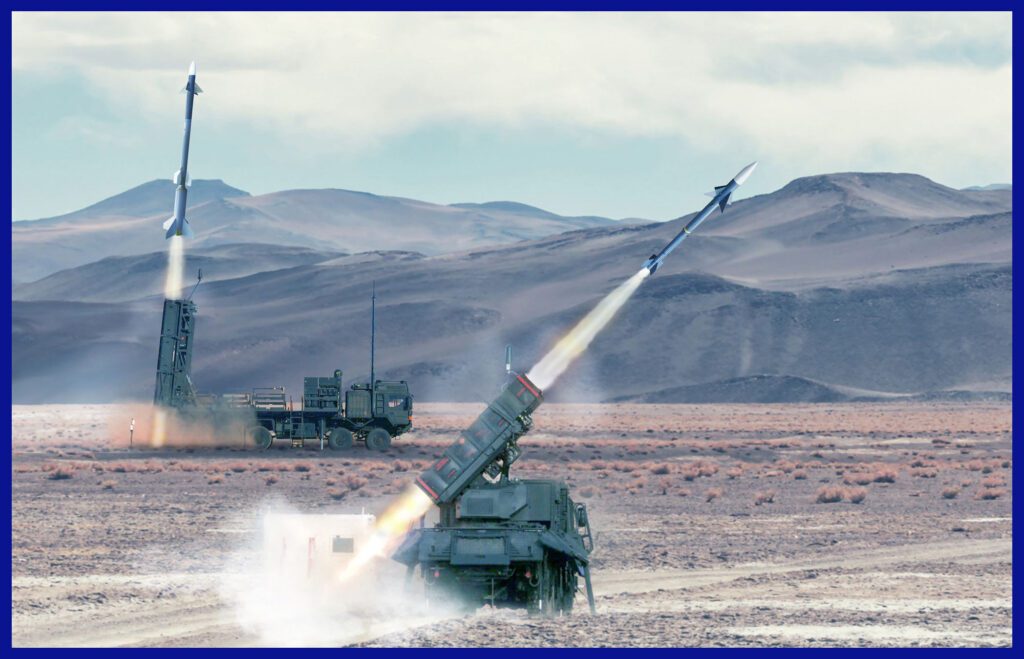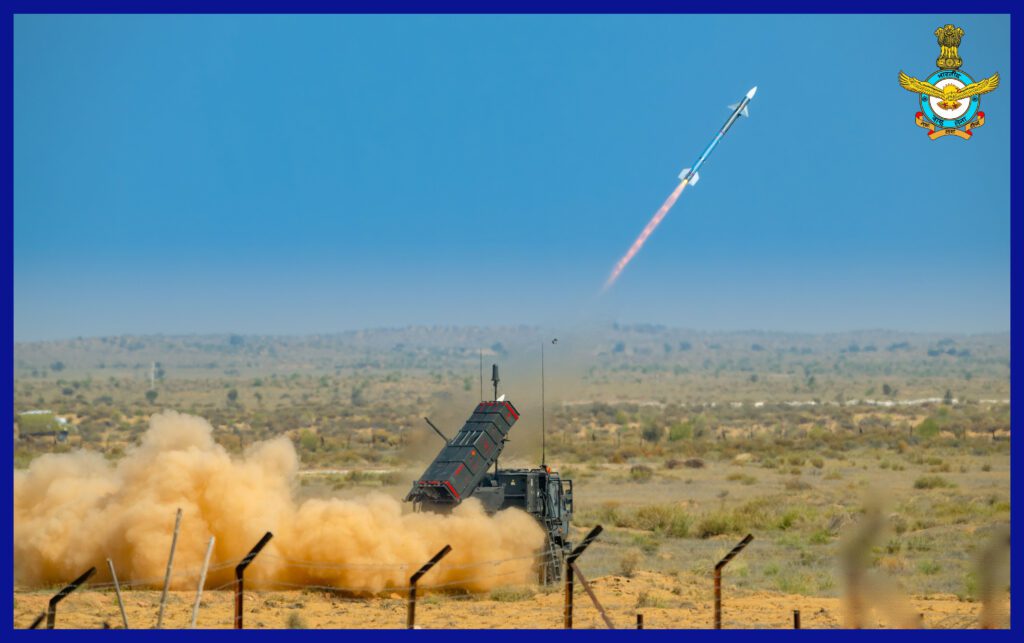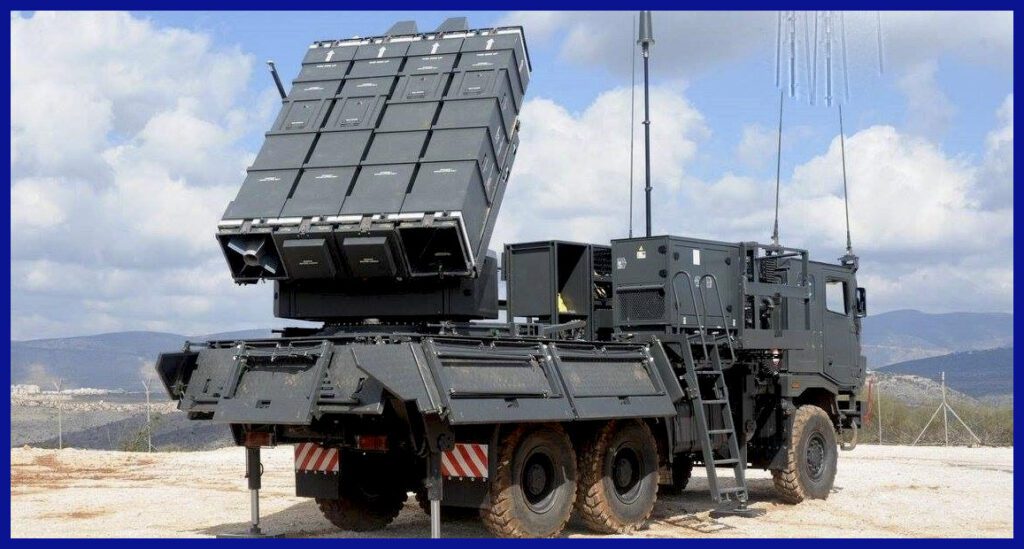The Spyder Air Defence System has been successfully integrated into various military forces around the world, showcasing its remarkable adaptability and effectiveness in safeguarding airspace against diverse aerial threats. The Israeli Origin Spyder Air Defence System For The IAF, is an advanced short-to-medium-range surface-to-air missile system developed by the Israeli Defence Electronics Company, Rafael Advanced Defense Systems, with additional assistance from Israel Aerospace Industries (IAI). The system is a combination of both Python and Derby as Spyder (Surface-to-air PYthon and DERby) SAM system.

Its formidable capabilities make it a crucial and indispensable component of modern air defence strategies, and it is widely recognized as one of the most potent and dominant short-to-medium-range surface-to-air missile (SAM) systems in the world, with a max speed of Mach 4, making it virtually unstoppable against any aerial threats.
Israeli Origin Spyder Air Defence System For The IAF ( Indian Air Force ) is designed to provide protection against aircraft, helicopters, unmanned aerial vehicles, precision-guided munitions, and cruise missiles. The SPYDER system is capable of launching both Python and Derby missiles, which are highly manoeuvrable and have a range between 20 to 50 km. The system is mobile and can be mounted on a variety of platforms, including trucks and trailers. It has been exported to several countries, including India, Singapore, and Vietnam.

The Python-5 and Derby surface-to-air missiles, which are meant to be fired by the SPYDER launcher, have full compatibility with air-to-air missiles. The SPYDER comes in two different versions: the SPYDER-MR for medium range and the SPYDER-SR for short range. Both systems provide rapid response, all-weather, network-centric, multiple launchers, and self-propulsion capabilities.
A standard battery configuration comprises a central command and control unit, six missile firing units, and a resupply vehicle. The SPYDER-SR variant is equipped with the EL/M-2106 ATAR radar, while the SPYDER-MR variant utilizes the EL/M-2084 MMR radar, which is also employed by the Iron Dome system, currently in active service with the Israel Defense Forces.
India and Singapore are two of the system’s current operators. In 2012, the SPYDER order from Peru was still pending. According to certain accounts, Georgia used the SPYDER-SR during the 2008 Russo-Georgian War, although these claims and presumptions have never been proven.

Development Of The Spyder SAM System
The Spyder surface-to-air missile ( SAM ) system was developed by the Israeli defence electronics company Rafael Advanced Defense Systems with assistance from Israel Aerospace Industries ( IAI ). The development of the system began in the 1990s as a joint venture between Rafael and Israel Aircraft Industries ( IAI ), with the goal of creating a highly effective and versatile air defence system that could protect both ground-based assets and airborne platforms.
The system was designed with a combination of two missile types: the Python 5 and Derby. The Python 5 missile is a highly manoeuvrable and agile missile with an advanced seeker and guidance system, making it highly effective against a wide range of targets, including fast-moving aircraft and cruise missiles. The Derby missile is a beyond-visual-range missile with a range of up to 50 km and an advanced guidance system that allows it to engage multiple targets simultaneously.
The SPYDER system also includes advanced radar and command and control capabilities, allowing it to detect and track targets at long ranges and rapidly engage them with the appropriate missile type. The system can be operated in both autonomous and manual modes, providing operators with maximum flexibility and control.
The year 2005 marked a pivotal moment for the SPYDER air defence system when it achieved a historic milestone. In a dramatic test conducted at the Shdema range in Israel, the SPYDER successfully launched and fired the lethal Python 5 and Derby missiles, obliterating two targets in their path. The trial was a resounding success, demonstrating the SPYDER’s formidable firepower and advanced radar and command and control capabilities, which enabled it to engage and destroy the targets at both long and short ranges.

The SPYDER’s performance in this trial was a testament to its status as one of the most lethal and dominant short to medium-range surface-to-air missile systems in the world. This accomplishment was just one of many successful tests in a greater series of missile firings, cementing the SPYDER’s reputation as a true force to be reckoned with in the field of air defence.
The development process involved a rigorous testing and evaluation program, with the system undergoing extensive trials in various environments and scenarios. The SPYDER system was designed to be highly mobile and flexible, with the ability to move quickly and set up in a new location. It was also designed to be modular and easily upgradeable, with new capabilities and technologies able to be added as they become available.
Overall, the development of the SPYDER SAM system was a highly complex and challenging process, involving the integration of multiple advanced technologies and capabilities. However, the end result was a highly effective and versatile air defence system that has been widely adopted by military forces around the world.

The Capabilities Of The Spyder Missile System Include
Rapid response capabilities are available with both lock-on-before-launch (LOBL) and lock-on-after-launch (LOAL) capabilities using the SPYDER-SR and SPYDER-ER 360° slant-launching missile systems. The defence range is greatly increased by these cutting-edge systems, which effectively cover a 40 km radius. Moreover, the deployment of the SPYDER-MR and SPYDER-LR systems, which excel at medium and long-range target interception through their vertical launch capabilities, further expands the defence envelope up to an astonishing 80 km radius.
Both the SPYDER-MR and SPYDER-LR systems are designed to provide all-weather, multi-launch, and net-centric capabilities, empowering them to launch a 360-degree missile within seconds of designating the target as hostile. It is important to note that the SPYDER systems boast advanced ECCM (Electronic Counter-Countermeasures)
capabilities and are equipped with electro-optical observation payloads, as well as utilising wireless data link communication for enhanced performance and coordination.
In January 2023, Rafael made a significant announcement stating that they had successfully upgraded the Spyder system, equipping it with enhanced capabilities to effectively counter tactical ballistic missiles. This breakthrough was achieved through comprehensive hardware and software upgrades, specifically focusing on bolstering the performance of the Derby LR missile interceptor.
The SPYDER systems use wireless data link communication, electro-optical observation payloads, and superior ECCM capabilities
- High mobility: The system is highly mobile, and can be easily transported to different locations to provide air defence cover.
- Multi-mission: The system can engage a wide variety of aerial threats including aircraft, helicopters, unmanned aerial vehicles, and precision-guided munitions.
- All-weather capability: The system can operate in all weather conditions, including fog, rain, and dust storms.
- High accuracy: The missiles used in the system have a high degree of accuracy, and can engage targets at short and medium ranges.
- Multi-target engagement: The system can engage multiple targets simultaneously, increasing its defensive capability.
- Network-centric operations: The system can be integrated with other air defence systems and operate as part of a network-centric air defence system.
Overall, the Spyder missile system is a highly capable air defence system designed to protect vital assets and populations against a range of airborne threats.

In total, 11 Countries Are Operating This System Including India
India has indeed acquired the Spyder air defence system from Israel’s Rafael Advanced Defense Systems. The Indian Air Force ( IAF ) received the first batch of Spyder missile systems in 2008, and subsequent orders have been placed to increase the number of systems in service.
The Spyder system has been deployed by the Indian armed forces to provide air defence cover to critical installations, such as airbases, oil refineries, and other sensitive areas. The system has also been used during military exercises to simulate air defence scenarios and to train air defence personnel.
In 2012, the Indian Armed Forces received a delivery of 18 Spyder-MR systems. These advanced systems are equipped with a formidable arsenal of 750 Python-5 surface-to-air missiles (SAMs) and 750 Derby SAMs. These sophisticated missiles have the capability to engage and neutralize a diverse array of airborne threats, encompassing aircraft, helicopters, cruise missiles, unmanned aerial vehicles, and precision-guided munitions.
In addition, the Spyder system has been deployed by the Indian Army along the Line of Control ( LoC ) with Pakistan to provide air defence cover to troops and military installations.
The Indian armed forces have expressed satisfaction with the performance of the Spyder missile system, particularly its mobility, accuracy, and multi-target engagement capability. The system has been integrated with other air defence systems in the Indian inventory to provide a layered air defence cover against a range of aerial threats.

Operational Usage By India
On 26th February 2019, during the tense aftermath of the Balakot Airstrike, the Indian Armed Forces showed their mettle when they deployed a SPYDER system to shoot down a surveillance drone belonging to the Pakistan Armed Forces. This decisive act of defence took place at the Indo-Pakistan Border in Gujarat, and it underscored India’s unwavering commitment to safeguarding its territorial integrity and national sovereignty. The use of the SPYDER system in this critical situation showcased its remarkable capabilities and demonstrated India’s formidable air defence posture.
On February 27, 2019, during the 2019 Jammu and Kashmir airstrikes, an Indian Air Force ( IAF ) Mil Mi-17 helicopter was tragically shot down in Budgam, Kashmir. The attack resulted in the loss of six IAF personnel who were aboard the helicopter, as well as one civilian on the ground.
Following the incident, a six-month investigation was conducted by the IAF to determine the cause of the helicopter’s downing. The investigation concluded that friendly fire was the cause, and identified five IAF members responsible for the tragic incident.
The mentioned incident serves as a poignant reminder of the intricacies involved in air operations, especially during high-pressure situations like military conflicts. The subsequent investigation and actions taken by the Indian Air Force (IAF) underscore the significance of accountability and transparency in dealing with such occurrences. The unwavering commitment of the Indian Armed Forces to uphold the utmost levels of safety and operational excellence remains resolute, even amidst the most daunting challenges.

The Latest Generation Spyder SAM Specifications
- Weight: 105 kg ( Python-5 ) and 118 kg ( Derby )
- Length: 10 ft ( Python-5 ) and 12 ft ( Derby )
- Diameter: 6.3 in ( both )
- Wing span: 25.19 in
- Warhead: 11 kg ( Python-5 ) and 23kg ( Derby )
- Detonation: Active laser proximity fuse ( In addition to Impact fuse )
- Engine: Solid fuel rocket motor
- Range: 20 km ( Python-5 ) and 50 km ( Derby )
- Speed: Mach 4
- Maximum number of simultaneous targets engaged: 6 targets
- Guidance: Infrared homing and electro-optical imaging ( for Python-5 ) and Active radar homing ( for Derby )
- Manoeuvrability: High-G manoeuvring capability
- Deployment time: less than 15 minutes
- Radar system: multi-function radar with 360-degree coverage
- Flight altitude: 30,000 ft ( Python-5 ) and 52,000 ft ( Derby )
- Launch Platform: Can be mounted on a mobile platform such as a truck or trailer

Furthermore, seize the chance to take advantage of this exclusive opportunity to acquire the exquisite large-scale 1/72 premium die-cast models of the formidable Israeli F-16 Fighting Falcon. These remarkable and iconic military jets, widely acclaimed as the epitome of advanced interceptors with an impeccable track record, were credited with 44 air-to-air kills during the conflict in the 1982 Lebanon war. They are now available for purchase on AirModels with worldwide delivery. Do not let this chance slip away to own these exceptional and meticulously crafted models that flawlessly encapsulate the essence of aviation history. Click here now to secure your piece before the limited stock is depleted.
In conclusion, the Spyder air defence system stands as a testament to Israel’s prowess in developing cutting-edge defence technologies. Its combination of Python and Derby missiles provides a versatile and robust solution against a wide array of aerial threats. With its proven track record in the field and its adaptability to various platforms, the Spyder system has earned its place as a sought-after asset by both the Israeli Defense Forces and international partners. As the global security landscape evolves, the Spyder system continues to play a crucial role in safeguarding airspace and protecting nations against airborne threats, setting a benchmark for excellence in SAM systems.
Important Announcement for Our Valued Readers!
After an article is published, it is possible that updates or changes may have occurred beyond the time of publication. Therefore, it is important to be aware that certain information in the article might be outdated. To ensure the most accurate analysis, it is highly recommended to verify the content with the latest sources available.
However, we are dedicated to delivering outstanding articles on military products and global updates. Maintaining quality and smooth operation requires resources. Your support sustains our efforts in providing insightful content. By purchasing high-quality products through our affiliated links, you help us keep our platform alive and acquire top-notch items. Your unwavering support is invaluable and inspires us to strive further.
We welcome your suggestions and requests for more information, as we value feedback from our readers. If there’s specific defence material or equipment not covered on our site, please share your request in the comments. We’ll strive to research and provide the required information. We sincerely thank you for your unwavering interest in our website, and we eagerly anticipate hearing from you! Enjoy your reading experience!
